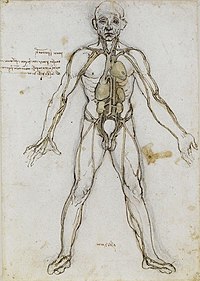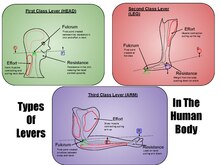| This list is incomplete; you can help by adding missing items. (November 2013) |
| This article needs additional citations for verification. Please help improve this article by adding citations to reliable sources. Unsourced material may be challenged and removed. Find sources: "List of movements of the human body" – news · newspapers · books · scholar · JSTOR (November 2013) (Learn how and when to remove this message) |
 |
| Part of a series of lists about |
| Human anatomy |
|---|
| General |
| Structures |
| Muscles |
| See also |

The list below describes such skeletal movements as normally are possible in particular joints of the human body. Other animals have different degrees of movement at their respective joints; this is because of differences in positions of muscles and because structures peculiar to the bodies of humans and other species block motions unsuited to their anatomies.
Arm and shoulder
Main articles: Sternoclavicular joint, Acromioclavicular joint, and Shoulder jointShoulder
Main article: Shoulder| Movement | Muscles | Origin | Insertion |
|---|---|---|---|
| Flexion (150°–170°) |
Anterior fibers of deltoid | Clavicle | Middle of lateral surface of shaft of humerus |
| Clavicular part of pectoralis major | Clavicle | Lateral lip of bicipital groove of humerus | |
| Long head of biceps brachii | Supraglenoid tubercle of scapula | Tuberosity of radius, Deep fascia of forearm | |
| Short head of biceps brachii | Coracoid process of scapula | ||
| Coracobrachialis | Coracoid process | Medial aspect of shaft of humerus | |
| Extension (40°) |
Posterior fibers of deltoid | Spine of scapula | Middle of lateral surface of shaft of humerus |
| Latissimus dorsi | Iliac crest, lumbar fascia, spines of lower six thoracic vertebrae, lower 3–4 ribs, inferior angle of scapula | Floor of bicipital groove of humerus | |
| Teres major | Lateral border of scapula | Medial lip of bicipital groove of humerus | |
| Abduction (160°–180°) |
Middle fibers of deltoid | Acromion process of scapula | Middle of lateral surface of shaft of humerus |
| Supraspinatus | Supraspinous fossa of scapula | Greater tubercle of humerus | |
| Adduction (30°–40°) |
Sternal part of pectoralis major | Sternum, upper six costal cartilages | Lateral lip of bicipital groove of humerus |
| Latissimus dorsi | Iliac crest, lumbar fascia, spines of lower six thoracic vertebrae, lower 3-4 ribs, inferior angle of scapula | Floor of bicipital groove of humerus | |
| Teres major | Lower third of lateral border of scapula | Medial lip of bicipital groove of humerus | |
| Teres minor | Upper two thirds of lateral border of scapula | Greater tubercle of humerus | |
| Lateral rotation (in abduction: 95°; in adduction: 70°) |
Infraspinatus | Infraspinous fossa of scapula | Greater tubercle of humerus |
| Teres minor | Upper two thirds of lateral border of scapula | Greater tubercle of humerus | |
| Posterior fibers of deltoid | Spine of scapula | Middle of lateral surface of shaft of humerus | |
| Medial rotation (in abduction: 40°–50°; in adduction: 70°) |
Subscapularis | Subscapular fossa | Lesser tubercle of humerus |
| Latissimus dorsi | Iliac crest, lumbar fascia, spines of lower 3-4 ribs, inferior angle of scapula | Floor of bicipital groove of humerus | |
| Teres major | Lower third of lateral border of scapula | Medial lip of bicipital groove of humerus | |
| Anterior fibers of deltoid | Clavicle | Middle of lateral surface of shaft of humerus |
The major muscles involved in retraction include the rhomboid major muscle, rhomboid minor muscle and trapezius muscle, whereas the major muscles involved in protraction include the serratus anterior and pectoralis minor muscles.
Sternoclavicular and acromioclavicular joints
Main articles: SC joint and AC joint| Scapula and clavicula | Abduction (Protraction) | Adduction (Retraction) |
| Depression | Elevation | |
| Rotation Upward (Superior Rotation) | Rotation Downward (Inferior Rotation) |
Elbow
Main articles: Elbow, Proximal radioulnar joint, Distal radioulnar joint, and Humeroulnar joint| Joint | From | To | Description |
|---|---|---|---|
| Humeroulnar joint | trochlear notch of the ulna | trochlea of humerus | Is a simple hinge-joint, and allows of movements of flexion and extension only. |
| Humeroradial joint | head of the radius | capitulum of the humerus | Is a ball-and-socket joint. |
| Superior radioulnar joint | head of the radius | radial notch of the ulna | In any position of flexion or extension, the radius, carrying the hand with it, can be rotated in it. This movement includespronation and supination. |
Wrist and fingers
Main articles: Wrist, finger, and thumb| Wrist & Midcarpals | Flexion | Extension / Hyperextension |
| Adduction (Ulna Deviation) | Abduction (Radial Deviation) |
Movements of the fingers
| Metacarpophalangeal | Flexion | Extension / Hyperextension |
| Adduction | Abduction | |
| Interphalangeal | Flexion | Extension |
Movements of the thumb
| Carpometacarpal (thumb) | Flexion | Extension |
| Adduction | Abduction | |
| Opposition | ||
| Metacarpophalangeal (thumb) | Flexion | Extension |
| Adduction | Abduction | |
| Interphalangeal (thumb) | Flexion | Extension / Hyperextension |
Neck
Main articles: Atlantooccipital articulation and atlantoaxial articulation| Neck (Atlantoccipital & Antlantoaxial) | Flexion | Extension / Hyperextension |
| Lateral Flexion (Abduction) | Reduction (Adduction) | |
| Rotation |
Spine
Main articles: Cervical spine, thoracic spine, and lumbar spine| Cervical spine | Flexion | Extension / Hyperextension |
| Lateral Flexion (Abduction) | Reduction (Adduction) | |
| Rotation | ||
| Thoracic spine | Flexion | Extension / Hyperextension |
| Lateral Flexion (Abduction) | Reduction (Adduction) | |
| Rotation | ||
| Lumbar spine | Flexion | Extension / Hyperextension |
| Lateral Flexion (Abduction) | Reduction (Adduction) | |
| Rotation |
Lower limb
| Hip (acetabulofemoral joint) | Flexion | Extension |
| Adduction | Abduction | |
| Transverse Adduction | Transverse Abduction | |
| Medial Rotation (Internal Rotation) | Lateral Rotation (External Rotation) |
Knees
Main article: Knee| Knee | Flexion | Extension |
| Medial Rotation (Internal Rotation) | Lateral Rotation (External Rotation) |
| Ankle | Plantar Flexion | Dorsi Flexion |
Feet
Main articles: Intertarsal, metatarsophalangeal, and Interphalangeal articulations of foot| Intertarsal - (foot) | Inversion | Eversion |
| Plantarflexion |
| Metatarsophalangeal (toes) | Flexion | Extension / Hyperextension |
| Abduction | Adduction |
| Interphalangeal (toes) | Flexion | Extension |
The muscles tibialis anterior and tibialis posterior invert the foot. Some sources also state that the triceps surae and extensor hallucis longus invert. Inversion occurs at the subtalar joint and transverse tarsal joint.
Eversion of the foot occurs at the subtalar joint. The muscles involved in this include fibularis longus and fibularis brevis, which are innervated by the superficial fibular nerve. Some sources also state that the fibularis tertius everts.
-
 Peroneus longus and peroneus brevis (centre left), the primary muscles involved in eversion
Peroneus longus and peroneus brevis (centre left), the primary muscles involved in eversion
-
 Tibialis anterior and posterior (centre top), the primary muscles involved in inversion
Tibialis anterior and posterior (centre top), the primary muscles involved in inversion
Dorsiflexion of the foot: The muscles involved include those of the Anterior compartment of leg, specifically tibialis anterior muscle, extensor hallucis longus muscle, extensor digitorum longus muscle, and peroneus tertius. The range of motion for dorsiflexion indicated in the literature varies from 12.2 to 18 degrees. Foot drop is a condition, that occurs when dorsiflexion is difficult for an individual who is walking.
Plantarflexion of the foot: Primary muscles for plantar flexion are situated in the Posterior compartment of leg, namely the superficial Gastrocnemius, Soleus and Plantaris (only weak participation), and the deep muscles Flexor hallucis longus, Flexor digitorum longus and Tibialis posterior. Muscles in the Lateral compartment of leg also weakly participate, namely the Fibularis longus and Fibularis brevis muscles. Those in the lateral compartment only have weak participation in plantar flexion though. The range of motion for plantar flexion is usually indicated in the literature as 30° to 40°, but sometimes also 50°. The nerves are primarily from the sacral spinal cord roots S1 and S2. Compression of S1 roots may result in weakness in plantarflexion; these nerves run from the lower back to the bottom of the foot.
Pronation at the forearm is a rotational movement at the radioulnar joint, or of the foot at the subtalar and talocalcaneonavicular joints. For the forearm, when standing in the anatomical position, pronation will move the palm of the hand from an anterior-facing position to a posterior-facing position without an associated movement at the shoulder joint). This corresponds to a counterclockwise twist for the right forearm and a clockwise twist for the left (when viewed superiorly). In the forearm, this action is performed by pronator quadratus and pronator teres muscle. Brachioradialis puts the forearm into a midpronated/supinated position from either full pronation or supination. For the foot, pronation will cause the sole of the foot to face more laterally than when standing in the anatomical position.
Pronation of the foot is a compound movement that combines abduction, eversion, and dorsiflexion. Regarding posture, a pronated foot is one in which the heel bone angles inward and the arch tends to collapse. Pronation is the motion of the inner and outer ball of the foot with the heel bone. One is said to be "knock-kneed" if one has overly pronated feet. It flattens the arch as the foot strikes the ground in order to absorb shock when the heel hits the ground, and to assist in balance during mid-stance. If habits develop, this action can lead to foot pain as well as knee pain, shin splints, achilles tendinitis, posterior tibial tendinitis, piriformis syndrome, and plantar fasciitis..
References
- Snell, Richard S. Clinical Anatomy by Systems. Lippincott Williams & Wilkins. pp. 427–428.
- shoulder/surface/scsurface4 at the Dartmouth Medical School's Department of Anatomy
- Scapula & Clavicle Articulations
- shoulder/surface/scsurface3 at the Dartmouth Medical School's Department of Anatomy
- Animation at exrx.net
- ^ Kyung Won, PhD. Chung (2005). Gross Anatomy (Board Review). Lippincott Williams & Wilkins. ISBN 0-7817-5309-0.
- "Gross Anatomy: Functional Anatomy Of The Ankle And Foot". Archived from the original on 2009-08-23. Retrieved December 18, 2013.
- Boone, Donna C.; Azen, Stanley P. (July 1979). "Normal range of motion of joints in male subjects". The Journal of Bone and Joint Surgery. 61-A: 756–759. Archived from the original on 26 May 2013. Retrieved 24 October 2012.
- American Academy of Orthopaedic Surgeons (1965). Joint Motion: Method of Measuring and Recording. Chicago: American Academy of Orthopaedic Surgeons.
- Roaas, Asbjørn; Andersson, Gunnar B. J. (1982). "Normal Range of Motion of the Hip, Knee and Ankle Joints in Male Subjects, 30–40 Years of Age". Acta Orthopaedica. 53 (2): 205–208. doi:10.3109/17453678208992202. PMID 7136564.
- Kendall, F. P.; McCreary, E. K.; Provance, P. G. (1993). Muscles Testing and Function (4th ed.). Lippincott Williams and Wilkins. ISBN 0-683-04576-8.
- Brukner, P.; Khan, K. (1993). Clinical Sports Medicine (1st ed.). McGraw-Hill Book Company. ISBN 0-07-452852-1.
- "Foot in the bottom of the foot – RealHealthyNet". Realhealthynet.com. July 11, 2012. Archived from the original on 2013-07-19. Retrieved August 30, 2013.